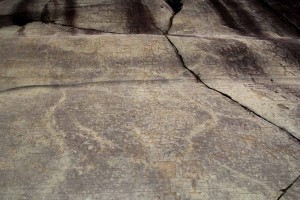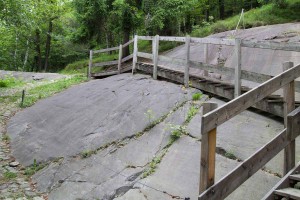
©Bigstock.com/AigarsR
The UNESCO established its list of World Heritage Sites by naming the first twelve places in Africa, Europa, North & South America in 1978. Italy got its first World Heritage Site the following year and it is one that takes you on a journey back to days long gone. The first rock drawings in Valcamonica in Lombardy were likely created as early as 8000 BC. Estimates range from 140,000 to over 300,000 of such Mesolithic to Iron Age depictions. Have you already packed your bags for your primeval tour? Great, let’s go!
About Valcamonica
Also known as Val Camonica, this area is a valley, as you might’ve already presumed correctly. To be more precise, it stretches across 70 km in the province of Brescia in Lombardy with the river Oglio running through it. Valcamonica (Latin “Vallis Camunnorium”, which translates to “Valley of the Camunni”) got its name from the Camunni, an Iron Age population and the ancestors of the Camuni, the valley’s current inhabitants.
Several nature and archaeology parks, all of which are closely connected to the rock drawings, aside, you’ll come across fascinating sights from Roman times and the Middle Ages. If you have a bit more time at hand, we recommend a trip to Brena and Cividate Camuno with their Roman ruins, the stunning medieval villages Bienno and Lovere, or the many picturesque churches and castles between mountains and the valley.
The Camunni
Despite only (presumably) populating the valley around the 1st century BC, the influence of the Camunni was significant for the heyday of the rock drawings in Valcamonica. It is likely that the cultural tradition of this people dates even further back to the early Neolithic. According to current evidence, it is believed that there were contacts with the Etruscans and the Celts. Both populations influenced the Camunni greatly. To this day, their name is closely connected to the rock drawings in Valcamonica, as they were responsible for a large number of such carvings.
Sadly, many things about the Camunni remain unknown. They only left very few written words below their drawings that experts cannot decipher properly – it is believed that their language was a mix of Etruscan and Celtic. The Romans conquered the Camunni region during founder-emperor Augustus’ campaign in Raetia and the Alpine arc. The empire granted the people a certain degree of self-government, Roman citizenship soon followed, and the primeval roots slowly began to fall into oblivion.
Characteristics and discovery of the rock drawings

©Bigstock.com/AigarsR
The rock drawings you discover during your tour – best with a guide for amazing insights into the various cultures populating the valley over thousands of years – were likely created over a long period of time. The first carvings were presumably made as early as the Mesolithic around 12000 BC. However, the most commonly found and best-known can be traced back to the Camunni around the 1st century BC.
To this day, the order and depiction of the individual figures poses a riddle. Some show clear hierarchies, other appear to have been carved into stone rather randomly. It is seen as proven, though, that most drawings are ideograms, i.e. depictions standing for an entire concept or idea. They frequently are of ritual and religious nature. Among the most famous rock drawings is the Camunian Rose – a flower-like carving that the region of Lombardy adopted as their official symbol.
First documented discoveries and documentations of these rock drawings date back to 1909, but it took scientists until the 1920s to start large-scale research projects. It wasn’t until after the Second World War that the first books on the civilisation of Valcamonica were published and symposia were held. Achieving UNESCO World Heritage Site status gave the research work another decisive push. More and more rock drawings were discovered and documented. While estimates around 1979 listed around 140,000 drawings, more recent research counts over 300,000.
The rock drawings in Valcamonica through the ages
Today you can see the rock drawings in Valcamonica in the following eight national and archaeological parks:
- Parco nazionale delle incisioni rupestri di Naquane (Capo di Ponte)
- Parco archeologico nazionale del Massi di Cemmo (Capo di Ponte)
- Parco archeologico comunale di Seradina-Bedolina (Capo di Ponte)
- Parco archeologico di Asinino-Anvòla (Ossimo)
- Parco comunale delle incisioni rupestri di Luine (Darfo Boario Terme)
- Parco comunale archeologico e minerario di Sellero
- Parco archeologico comunale di Sonico
- Riserva naturale incisioni rupestri di Ceto, Cimbergo e Paspardo
By now, six main epochs of rock carvings have been identified:
- Epipaleolithic: The earliest rock drawings arose around 12,000 years ago and had a predominantly shadowy look. From this era, you’re most likely to see depictions of the Holocene elk, who became extinct around 9500 BC.
- Neolithic: A new population ousted the hunters and gatherers. This period saw the first composition of two depictions into ideograms. Hunting, agriculture and technological achievements played a central role.
- Chalcolithic: New symbols depicting a cultural shift appeared until the start of the Bronze Age. Symbolic, religious ornaments left their mark on this epoch.
- Bronze Age: Metalworking and mining prevailed replacing depictions of daggers and axes with battle scenes. But there are also topographic maps and mythical scenes to be seen.
- Iron Age: Influences of the Etruscans and the Villanova culture lead to various inscriptions, complemented by Celtic attributes in later years. We can draw conclusions about civic infrastructure from other depictions.
- Roman Age & Medieval Age: Considerably less rock drawings were made after the Camunni territory had been incorporated into the Roman Empire. You’ll hardly be surprised that some carvings of this era carry Latin inscriptions. There was a brief revival in the Middle Ages as the mix of Christian and pagan symbols likely served the herdsmen as a pastime.
Countless rock drawings await you on your tours through the Valcamonica valley. No other place in the world provides insights as deep and as fascinating into old, otherwise likely long forgotten cultures. Take your time and go on a few trips to the surrounding towns and villages – ZAINOO wishes you an exciting stay!